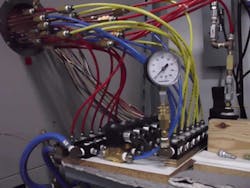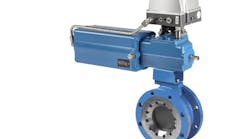Garfield Walker is a product manager at Parker Fluid Control Division in New Britain, Conn. He has been with the division for 13 years and specializes in mobile, medical and instrumentation markets. He has a bachelor’s degree in industrial technology from Central Connecticut State University. Mr. Walker can be reached at 860 827-2300 or [email protected].
Q: For many applications, valve sizing and selection will determine the ultimate success or failure of the larger process. In your opinion, what are the most important variables to consider when selecting and sizing a valve?
A: Process connections, system pressure, flowrate, Cv (i.e., flow coefficient value of valve), media (i.e., type & temperature), voltage, and ambient conditions. The process connections (i.e., pipe size and thread type) must be verified to ensure that the valve is properly integrated into the end-user application. A valve’s maximum pressure rating must meet or exceed the maximum system pressure for proper valve actuation. The flowrate is a critical factor in applications requiring a specific volume of fluid flow at various pressures. The Cv value, which is based on the valve’s orifice size and other factors, is used in flow calculations to determine a valve’s ability to meet the target flowrate. The wetted parts of the valve, such as the elastomeric seals and metals, must be compatible with the media. Electrical specifications such as voltage and ambient conditions are important to determine the proper solenoid coil specification and type of electrical enclosure required.
Q: Prior to engaging in the valve sizing and selection process, what specific application data should an end-user gather and assess to ensure a streamlined and successful process?
A: The end-user should gather application data, such as the valve’s installation environment (i.e., inside/outside, ambient temperature conditions), electrical requirements (connection type, voltage & current draw), valve duty cycle (i.e., valve on/off time), maximum and minimum system pressure, and media type (i.e., liquid or gas). The valve’s installation environment determines the most appropriate solenoid enclosure and coil temperature class. The electrical requirements are considered to ensure the solenoid’s integration in the end-user’s electrical power supply. Most solenoid valves are rated for continuous duty at a maximum ambient temperature. If a valve is used intermittently, the temperature rise is reduced significantly depending on the duty cycle. The minimum pressures are important for the proper actuation of pilot-operated valves and the maximum pressures should not be exceeded to avoid a valve failure. The media type is used to determine suitable elastomeric seals.
Parker Fluid Control Division’s 7000 Series brass body, two-way normally closed pilot-operated valve.
Q: Why is cavitation in particular an important factor to consider during the valve sizing and selection process?
A: Cavitation is important to consider because the high velocity of liquid can create low-pressure bubbles of air that result in an explosion and can cause pitting of the metal, especially in the orifice area of a valve. Pitting may lead to the erosion of the metal. In highly susceptible areas, such as the orifice, which is the gateway to the inlet and outlet of the valve, any damage would compromise the internal seal and result in leakage. This can become an issue in a valve that is oversized. A valve that is grossly oversized lacks sufficient fluid movement and will operate at a nearly closed position, which tends to restrict the fluid flow at the orifice (i.e., opening inside a valve body) and creates a high-velocity situation.
Q: What are some warning signs end-users could look for to identify valves that are improperly sized? What are some common reasons a valve would be improperly sized in the first place?
A: In the instance of an undersized valve, it will act as a restriction, and the system will have inadequate flow. In the case of an oversized valve, there will be insufficient pressure drop across the valve for it to fully open (pilot-operated valves). Some common reasons for improper sizing include selecting a valve solely based on a system pipe size, without regard to flowrate, and failure to consider restriction factors (i.e., system pipe size and length and components upstream and downstream in relation to the valve).
Q: What are the primary benefits of a proper valve sizing and selection strategy (cost, less downtime, etc.) and, correspondingly, what would be the potential dangers or negative impacts of choosing the wrong valve type or size?
A: The primary benefits of a properly sized valve include adequate fluid control and system flow. One example is commercial laundry washing equipment, which uses a variety of valves to dispense various fluids into the washer. At designated intervals in a wash cycle, each valve will be actuated to dispense a particular fluid. Valves that are properly sized for the application will dispense a sufficient volume of fluid (water, detergent, bleach, etc.) during the wash cycle and ultimately impact system efficiency. The danger of selecting the wrong type includes shortened valve life or failure. Erratic operation may result in applications where a valve is grossly oversized. For example, large pilot-operated valves require sufficient pressure drop and fluid flow to actuate properly. The main diaphragm may flutter from the main orifice when there is an insufficient pressure drop. As a result, the erratic operation may lead to opening and closing failures, leakage, or premature wear of internal components.
Q: While valve manufacturers offer a variety of tools, such as software programs, to assist users with valve sizing and selection, it can be a little unnerving for end-users to rely on such tools for the specification of technology. In your opinion, how effective are today’s valve sizing and selection tools in identifying the appropriate solution for a given application?
A: The valve sizing tools are an excellent way to narrow down the list of appropriate valves for an application. These software programs are great tools because many capture pertinent data necessary to calculate flow requirements, media compatibility, voltage, etc., all of which are key to appropriate valve selection. A consultation with the valve’s OEM technical support is a positive last step. Ultimately, the end-user should test the valve in an application to confirm suitability.
Q: What are some of the key improvements you’ve seen in the way valves are sized and selected today as compared to the past, and how do you see the sizing and selection process evolving? In other words, how is the process of valve sizing and selection today better than it was yesterday, and how will the process be improved for tomorrow?
A: For the most part, valve selection is a manual process that involves an engineer collecting application data and using formulas and a product catalog to make a final selection. The process is becoming more automated with software. In the future, the process may allow valve manufacturers to factor elements of the customer system upstream and downstream of the valve.




